Fourth week in space
What is Thomas Pesquet doing on the International Space Station? Here are the details for last week and a look at the highlights for this week. Almost every day in space for all astronauts involves at least 90 minutes of exercise to keep fit and daily planning conferences with ground control, these will not be mentioned every time.
Monday 12 December
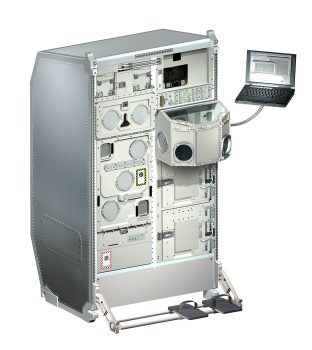
The European Biolab facility, designed to support biological experiments. Credits: ESA
Thomas started the week helping Peggy take a sample of her blood for general research. After the daily planning conference Thomas took a sample of his faeces for the Japanese Multi-Omics research into how the natural equilibrium of bacteria in astronauts changes in space. Thomas then spent an hour cleaning and maintaining the European Biolab facility that is used for research on micro-organisms and cells. Afterwards Thomas and Shane did a last training on the robotic systems to prepare for the arrival of the Japanese cargo vessel HTV-6 the next day.
After lunch Thomas worked on the Space Station’s environmental health system changing a waste water bag. Together with Shane and Peggy they then recorded a message for the holiday season. Thomas did his bicycle exercise and then worked on HTV-6 doing some pre-berthing checks. Before the end of the day the crew had a special conference call with ground control to discuss the HTV cargo and how to unpack it.
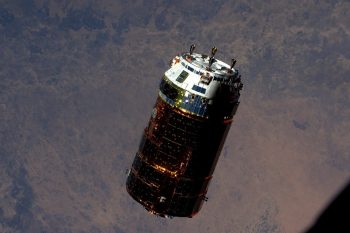
HTV-6 approaching ISS on Tuesday December 13. Credits: ESA/NASA-Thomas Pesquet
Tuesday 13 December
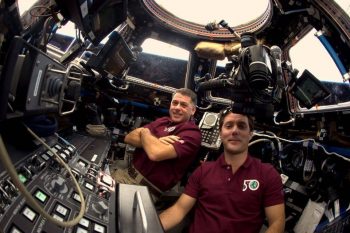
Thomas and Shane before working on capturing the HTV-6 from the Cupola. Credits: ESA/NASA
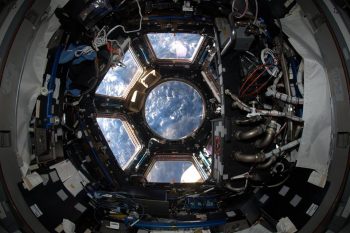
The Cupola observatory without the robotics work station. Credits: ESA-Thomas Pesquet
Tuesday started with the arrival of HTV-6. Thomas helped commander Shane grapple the Japanese HTV-6 supply spacecraft using the Station’s 16-m robotic arm. With that done, Thomas had a standard private medical conference and did his morning’s exercise.
After lunch Thomas worked on maintaining the life-support system by draining a tank and transferring waste urine. As commander Shane and Peggy worked on getting ready to open the HTV-6 hatch Thomas started returning the Cupola observatory to normal operations without the robotics workstation that was setup for receiving HTV-6.
Wednesday 14 December
On Wednesday Thomas worked on the Space Station’s water supply, taking samples and doing another session with the Aquapad experiment that aims to simplify testing the safety of the water. He is also did an eye exam and another session of the Fine Motor Skills experiment that is looking at how his muscles and reaction times adapt to space.
After lunch the whole crew had a safety review with the new module that arrived the day before – HTV-6. Thomas continued working on the new safety procedures in the afternoon.
Thursday 15 December
Thomas started the day taking a saliva sample for the Multi-Omics research and worked on the European Columbus laboratory power supply.
The rest of the day was spent on eyes and water. Peggy and Thomas ran eye exams on each other with guidance from ground control using both optical diagnostic equipment and a fundoscope.
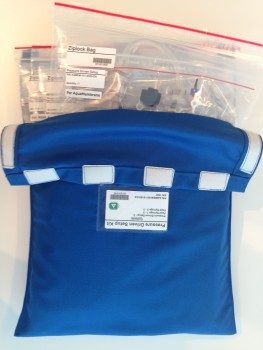
Aquamembrane launch kit (ESA astronaut Andreas Mogensen’s Iriss mission in 2015). Credits: Aquaporin Space Alliance
Thomas started work on the AquaMembrane experiment that uses reverse osmosis to purify water – its use could simplify water filtration without heavy machinery. This involved taking some Space Station water and putting it into the AquaMembrane bags for it to filter through, wait until finished and repeat.
Friday 16 December
On Friday morning Thomas did the last session of AquaMembrane for the week and then with Peggy used ultrasound to image each other’s eyes. Afterwards Thomas worked on Bioloab’s glovebox to get it ready for more experiments and did a double-dose of exercise.
After lunch Thomas installed the Medical Consumable Tracking hardware and performed a functional checkout. He worked on rerouting cables in the Japanese Kibo module and installed modules in the NanoRacks platform that is offering commercial use of hardware on the International Space Station.
THIS WEEK (18 – 23 December 2016)
This week sees Thomas take up work with the Mares muscle machine again for the SARCOLAB-3 experiment, focussing once again on his ankle and knees. He will also work in the Kibo laboratory to launch a miniature


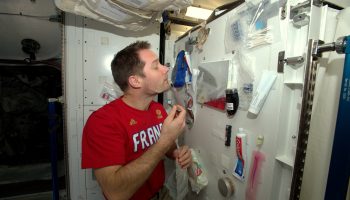


Discussion: one comment
Bonjour Monsieur Pesquet
Je m’appelle Albane, j’ai 5 ans et demi. Je suis votre parcours,c’est très intéressant, on regarde vos photos prises depuis la station, on a essayé de vous voir passer au dessus de la maison début décembre. J’ai une question, où sont vos toilettes dans la station ? et votre lavabo? on a vu où vous dormiez.
Merci à vous, bonne année à vous.